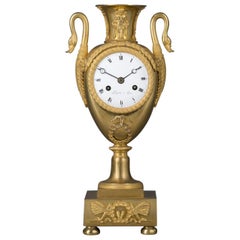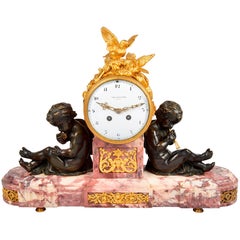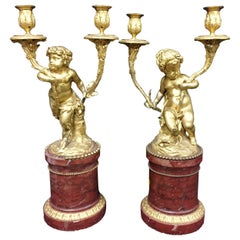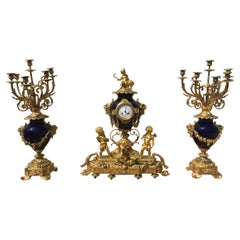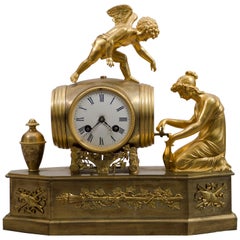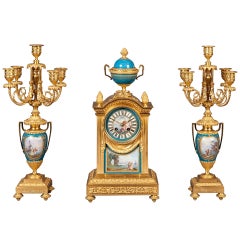European Mantel Clocks
to
207
1,959
31
5
121
1,530
308
36
191
76
19
50
18
42
23
5
5
9
10
7
1
321
201
109
108
98
72
54
26
23
19
17
16
13
9
3
1
1
1
1,673
988
643
633
520
1,239
620
1,995
1,582
159
120
71
Height
to
Width
to
1,995
1,968
1,993
33
25
24
19
17
Place of Origin: European
Empire Clock in the Form of a Classical Urn, by Maison Lepautre, circa 1825
By Pierre-Basile Lepaute
Located in Brighton, West Sussex
A gilt bronze Empire clock in the form of a classical urn, by Maison Lepautre.
French, circa 1825.
The dial signed 'Lepaute a Paris'.
The clock has an ornate cast bezel with a 3-inch porcelain dial with Roman numerals and Breguet style hands. The twin train eight-day movement with outside count wheel striking on a bell and silk thread suspension.
This elegant Empire style clock has a gilt bronze case in the form of a classical urn with swan neck handles and a winged cherub to the neck. The circular pedestal base is raised on a footed stepped square plinth.
The Lepaute family were the premier French clockmakers of their day. Their significance lies in their contribution to the clock making industry which had hitherto come under the trade of locksmiths. The family held the brevet Horlogers du Roi.
Jean-André Lepaute (1720–1789) arrived in Paris at an early age and in 1740 founded the family business. A skilled artist and mechanic, he quickly gained an excellent reputation. He was received as maître by the clockmakers guild in 1759, was granted royal lodgings from the king in The Luxembourg Palace, and was entrusted with the construction of the majority of the great public clocks of Paris. He executed, amongst others, those in The Luxembourg Palace, the Jardin des Plantes, the Château de Bellevue and the Château des Ternes. His clock at Paris’s École Militaire still works today. Three editions of his Traité d’Horlogerie were published in Paris in 1755, 1760 and 1767. A small volume, Description de Plusieurs Ouvrages d’Horlogerie appeared in 1764. Jean-André’s wife, Nicole-Reine Etable de la Brière (1723-1788), was a highly esteemed mathematician and astronomer. Her passion for science lent itself to Lepaute’s work and she played an active role in the scientific and mathematical aspects of the clock making.
Jean-André’s younger brother Jean-Baptiste Lepaute (1727-1802) joined him in Paris in 1747 and immediately started working for the family business. He was received as maître in 1776 and was known for the clocks he constructed for the Paris Hôtel de Ville (1780), destroyed in a fire of 1871, and for the Hôtel des Invalides (1784). Jean-Baptiste took over the workshop when Jean-André retired in 1775.
After Jean-Baptiste’s death in 1802, the firm was taken over by his nephew Pierre-Basil Lepaute (1750-1843) where he was duly joined by his own nephew Jean-Joseph (1768-1846) and son Pierre-Michel (1785-1849). By 1816, Pierre-Michel Lepaute was in charge of the business. His masterpieces include the astronomical clock in Paris’s Bureau...
Category
Early 19th Century Empire Antique European Mantel Clocks
Materials
Bronze
Louis XVI Style Mantel Clock with Doves and Putti Playing Pipes
By Hamilton & Inches Ltd.
Located in Brighton, Sussex
A good quality French gilded ormolu, bronze and rouge marble mantel clock, in the Louis XVI style. Having Doves above the clock face, an enamel dial with an eight day movement, chiming on the hour and half hour. Bronze putti on either side play the pipes and mounted on a rouge marble base.
Maker name; Hamilton and inches...
Category
19th Century Louis XVI Antique European Mantel Clocks
Materials
Marble, Bronze, Ormolu
Pair Louis XVI Style Candelabra, 19th Century
By Claude Michel Clodion
Located in Brighton, Sussex
A good quality pair of French gilded ormolu and rouge marble candelabra, depicting two putti each supporting a two branch candelabra.
Category
1860s Louis XVI Antique European Mantel Clocks
Materials
Marble, Bronze
$5,100 / set
Napoleon III, Gilt Bronze and Porcelain Mantel Clock, 19th Century
Located in Beaune, FR
Imposing and magnificent fireplace gilded bronze and blue porcelain vases. The clock is decorated with putti representing the 4 seasons. It is su...
Category
19th Century Napoleon III Antique European Mantel Clocks
Materials
Bronze
Early 19th Century French Empire Ormolu Mantel Clock "Pouring Wine"
Located in Tarzana, CA
A fine Early 19th century French Empire ormolu bronze mantel clock.
Depicting a winged cherub standing atop a barrel while a kneeling lady pouring wine ...
Category
19th Century Empire Antique European Mantel Clocks
Materials
Bronze
French Mantel Clock and Candelabra of Gilt Bronze and Blue ‘Sèvres’ Porcelain
Located in London, GB
A Good French mantel clock garniture
By Charles Oudin, Paris
The garniture comprising a clock and two candelabras, constructed in gilt bronze and ‘Se...
Category
19th Century Antique European Mantel Clocks
Materials
Ormolu
Gilt Bronze Eight-Day, Four-Face Clock with Date, Temperature and Barometer
Located in Tarzana, CA
A French gilt bronze eight-day four face mantel clock with date, temperature and barometer,
circa 1855.
Origin: France.
Dimensions: Height: 9....
Category
19th Century Antique European Mantel Clocks
William IV Rosewood and Bronze Bracket Clock by Frodsham 185 & Baker
Located in Lymington, Hampshire
William IV rosewood and bronze bracket clock by Frodsham 185 & Baker, the brass eight-day movement striking on a bell, the backplate numbered ‘292’, the circular brass dial with roman numerals and an engine turned centre, signed ‘Frodsham & Baker Gracechurch St. London‘, in an architectural case with applied panels, the front decorated with a lion and foliage, the corners with quoins, the sides with scrolling leaves and palmettes, with a fan pagoda top with a retractable oriental gateway handle, on leaf scroll feet, with pendulum, winding key and case key. English, circa 1830.
William Frodsham was an established London clockmaker. One of his sons, John Frodsham (1785-1849), went into partnership with Baker to form ‘Frodsham and Baker’ in 1809’. They were chronometer makers to the Admiralty and also made wall...
Category
1830s Antique European Mantel Clocks
Materials
Bronze
19th Century French Ormolu Mantle Clock in the Louis XV Rococo Style
Located in London, GB
An Elegant Mantle Clock
In the Louis XV Manner
The clock and its plinth executed in gilt bronze in a dynamic rococo style, rising from scrolling foliage, the dial in the shape of a ...
Category
19th Century Louis XV Antique European Mantel Clocks
Materials
Ormolu, Bronze
Victorian Antique Porcelain Mantel Clock by Benjamin Lewis Vulliamy, London
By Benjamin Lewis Vulliamy
Located in Devon, GB
A fine early 19th century Coalport Porcelain cased timepiece by this famous maker.
The elaborate pink ground porcelain case is set with exotic birds and flowers on scroll feet, wi...
Category
19th Century William IV Antique European Mantel Clocks
Materials
Porcelain
Arthur WAAGEN Japanese-style clock set
Located in SAINT-OUEN-SUR-SEINE, FR
By Arthur WAAGEN (active 1869-1910).
Japanese-style clock set. Made out of spelter.
Representing a young woman dressed in a kimono
Category
19th Century Japonisme Antique European Mantel Clocks
Materials
Ormolu
H. Luppen & Cie, Bronze and Marble Three-Piece Mantel Clock Set
Located in New York, NY
A fabulous ormolu-mounted and patinated bronze white and blue turquin marble three-piece clock set of putti. Comprising a mantel clock and a pair of five-light candelabras molded wit...
Category
19th Century Antique European Mantel Clocks
Materials
Carrara Marble, Marble, Bronze
Louis XVI Style Porcelain Mounted Figural Clock, Allegorical of the Arts
Located in Brighton, West Sussex
A Louis XVI style gilt bronze and Sèvres style porcelain mounted figural clock, Allegorical of the Arts.
The dial signed 'Colin, Paris'.
The movement stamped 'Vincenti et Cie'.
...
Category
19th Century Louis XVI Antique European Mantel Clocks
Materials
Ormolu
Antique Continental Gilt Bronze, Cut Glass, and Porcelain Clock Set
Located in London, GB
Antique Continental gilt bronze, cut glass, and porcelain clock set
Continental, late 19th century
Clock: Height 45cm, width 30cm, depth 22cm
Candelabra: Height 46cm, width 23cm, ...
Category
Late 19th Century Antique European Mantel Clocks
Materials
Ormolu
French Mid-19th Century, Louis XVI St. Ormolu and White Carrara Marble Clock
Located in West Palm Beach, FL
A most exquisite French mid 19th century Louis XVI st. ormolu and white Carrara marble clock. The clock is raised by topie shaped ormolu supports, The rectangular marble base is deco...
Category
19th Century Louis XVI Antique European Mantel Clocks
Materials
Carrara Marble, Ormolu
Recently Viewed
View AllMore Ways To Browse
Green Mantel Clock
Key Wind Clock
Louis Picard
Pendulum Clock Gilt Bronze
Pillar Clock
Used Street Clocks
American Antique Mantel Clocks
Antique Novelty Clocks
Antique School Clocks
Arts And Crafts Oak Clocks
Black Onyx Clock
Black Victorian Mantle
English Fusee Clock
French Clocks Greek
French Regulator Clock
Garniture Cheminee
Marble And Slate Mantel Clocks
Samuel Marti Bronze Clock
